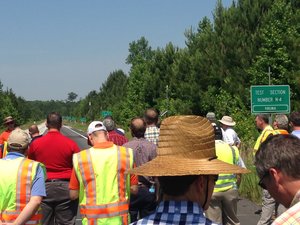NCAT Test Track Update
Print this Article | Send to Colleague
On May 25 and 26 the National Center for Asphalt Technology (NCAT) hosted their Spring Track Meeting. This gathering of state and industry track sponsors is intended to give an update on the current progress of the 2015 track cycle. Just over 2-million equivalent single axle loads (ESALs) have been applied by way of loaded tractor-trailers since the track cycle began in October. Of particular interest are the VDOT sponsored recycled sections: N3, N4, and S12. Each of these sections feature a cold-central plant recycled (CCPR) layer and, in one case, a cement-stabilized base to simulate full-depth reclamation (FDR). Section N3 features 6 inches of HMA over 5 inches of CCPR, Section N4 includes 4 inches of HMA over 5 inches of CCPR,  and section S12 uses 4 inches of HMA over 5 inches of CCPR over 8 inches of cement stabilized base. All of the Virginia sections were constructed in the 2012 track cycle and had undergone 10-million ESAL’s with minimal rutting and no cracking. As a matter of perspective, the heavily trafficked recycled sections on Interstate-81, placed in 2011 outside of Staunton, have only experienced approximately 9.6 million ESAL’s since construction. After a total of 12-million ESAL’s (10-million from 2012-2014 and 2- million from 2015-present) these sections on the NCAT track continue to perform well and are tracking in performance similar to perpetual pavement sections constructed at NCAT that underwent over 30-million ESAL’s with no reduction in performance. The data collected from these three test sections continues to be a major focus of the sponsor meetings and are of much interest nationally.
and section S12 uses 4 inches of HMA over 5 inches of CCPR over 8 inches of cement stabilized base. All of the Virginia sections were constructed in the 2012 track cycle and had undergone 10-million ESAL’s with minimal rutting and no cracking. As a matter of perspective, the heavily trafficked recycled sections on Interstate-81, placed in 2011 outside of Staunton, have only experienced approximately 9.6 million ESAL’s since construction. After a total of 12-million ESAL’s (10-million from 2012-2014 and 2- million from 2015-present) these sections on the NCAT track continue to perform well and are tracking in performance similar to perpetual pavement sections constructed at NCAT that underwent over 30-million ESAL’s with no reduction in performance. The data collected from these three test sections continues to be a major focus of the sponsor meetings and are of much interest nationally.
 and section S12 uses 4 inches of HMA over 5 inches of CCPR over 8 inches of cement stabilized base. All of the Virginia sections were constructed in the 2012 track cycle and had undergone 10-million ESAL’s with minimal rutting and no cracking. As a matter of perspective, the heavily trafficked recycled sections on Interstate-81, placed in 2011 outside of Staunton, have only experienced approximately 9.6 million ESAL’s since construction. After a total of 12-million ESAL’s (10-million from 2012-2014 and 2- million from 2015-present) these sections on the NCAT track continue to perform well and are tracking in performance similar to perpetual pavement sections constructed at NCAT that underwent over 30-million ESAL’s with no reduction in performance. The data collected from these three test sections continues to be a major focus of the sponsor meetings and are of much interest nationally.
and section S12 uses 4 inches of HMA over 5 inches of CCPR over 8 inches of cement stabilized base. All of the Virginia sections were constructed in the 2012 track cycle and had undergone 10-million ESAL’s with minimal rutting and no cracking. As a matter of perspective, the heavily trafficked recycled sections on Interstate-81, placed in 2011 outside of Staunton, have only experienced approximately 9.6 million ESAL’s since construction. After a total of 12-million ESAL’s (10-million from 2012-2014 and 2- million from 2015-present) these sections on the NCAT track continue to perform well and are tracking in performance similar to perpetual pavement sections constructed at NCAT that underwent over 30-million ESAL’s with no reduction in performance. The data collected from these three test sections continues to be a major focus of the sponsor meetings and are of much interest nationally.An additional benefit of the NCAT Spring Track Meeting is that state and industry sponsors have the opportunity to learn about all the other work that is ongoing at NCAT. Current projects of interest include: crack mitigation studies utilizing rubber modified and highly polymer modified binders, among others; asphalt laboratory cracking tests; structural performance utilizing materials such as CCPR, highly polymer modified binders, and rubber modified binders; and different pavement preservation treatments. There is a lot of encouraging information and research ongoing that will greatly benefit that asphalt industry. For more information visit the NCAT website at www.NCAT.us.
